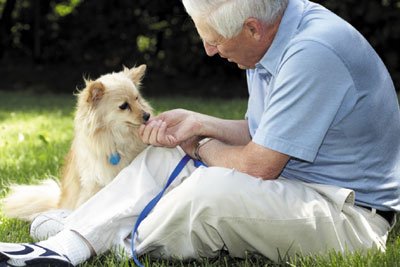In my last column, we
”
touched
”
on touch. This week, we explore the pros and cons of pets for
the elderly. What do we do with our pets? We touch them; pet them,
hold them, groom them and care for them. Many older adults who
acquire a pet later in life, do so in order to have a
companion.
In my last column, we “touched” on touch. This week, we explore the pros and cons of pets for the elderly. What do we do with our pets? We touch them; pet them, hold them, groom them and care for them. Many older adults who acquire a pet later in life, do so in order to have a companion.
Dr. Suzanne Colbert and Kathy Marsh, of Princevalle Pet Hospital, said pets are wonderful companions for older people, but should never be given as a surprise gift to anyone.
Colbert and Marsh remind us that pets require a commitment that can typically last 10 to 20 years. There is so much to consider, especially when you are retired: travel plans, finances and health concerns to name a few. When considering which pets are best suited for you, Petfinder.com says that the new pet must fit the physical capabilities of its keepers with an eye toward what the next 10 to 15 years will bring.
We all have a preference when it comes to the type of pet we want to share our home with, but I am going to focus on dogs.
I had an opportunity to talk with Bill Zeigler, who owns and operates The Pet Stop in Gilroy. I stopped by to inquire about his experiences with older customers, and couldn’t help but fawning over the playful puppies.
“Nine times out of 10, when older couples come in looking for a dog, the woman will typically want to purchase a small dog and the husband will initially say, ‘no way,'” Bill said. “It’s funny because the husbands eventually say yes and two weeks later, they’re the ones coming in, with the new puppy mind you, to purchase treats and toys for their beloved little dog; they’re totally hooked.”
Bill said older people who come into his shop usually purchase small, low-maintenance dogs such as bichon frises, shih tzus and Yorkshire terriers. According to Petfinder.com, toy dogs – especially Yorkies – are touch-sensitive creatures that do not weather rough handling well. These dogs do well in mellow environments.
On the opposite end of the size spectrum, Colbert and Marsh said that they have an older lady who cares for an akita inu. These are usually two and a half feet tall and can weigh up to 120 pounds. Colbert and Marsh said at least a quarter of their clients are over the age of 65, and that these older people own dogs in all shapes and sizes.
“Some older people feel safer with big dogs, especially if they live alone,” Colbert said. “And for those people who have arthritis or who have trouble bending over, bigger dogs are easier to reach.” She points out however, that big dogs can also be dangerous. “When my mom comes over to visit, I definitely lock up my dogs. She used to pet sit for us, but as she has gotten older, I don’t want to risk an injury; the dogs could jump on her and knock her down.”
According to Petfinder.com, when you are considering a pet for your household, ask yourself questions such as: How old are family members? Are there frail elderly or physically challenged individuals in the household? If so, strong, adolescent dogs as aging hips and wrists of the elderly are not safe. And don’t forget tails: big wagging can sometimes lead to big bruises.
Keep these things in mind if you own a big dog and are having an older friend or family member over to visit. If you are providing full time care for an older individual in your home, you’ve got to keep their safety and security in mind at all times.













